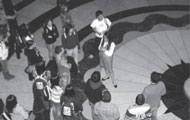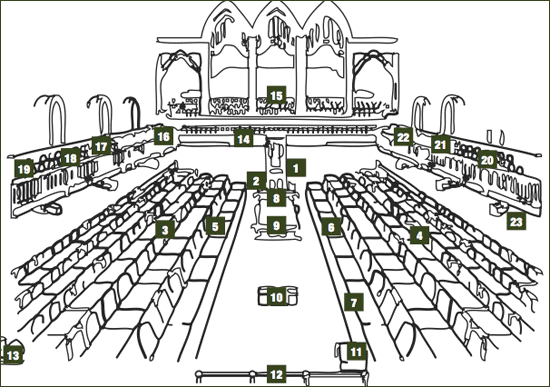Find Out More About Canada's Members of Parliament
For more than 140 years, Members of Parliament have participated in the development of Canadian democracy. Members represent the regional and local concerns of the citizens who elect them. They also represent Canada when travelling abroad on official business or when hosting visits by foreign dignitaries.
OUTREACH PROFILE
Parliamentary Guide Program
Every year, visitors from all over Canada and around the world are guided through the historic corridors of the Parliament Buildings. These tours are provided by the Library of Parliament by bilingual guides selected from university students across Canada.
Throughout the year, tours are offered of the Centre Block (including the Senate and House of Commons), the Library of Parliament, the Peace Tower and the Memorial Chamber. In the summer months, senior parliamentary guides provide interpretation of the reconstructed historical rooms in Parliament's East Block, including the offices of Canada's first Prime Minister, Sir John A. Macdonald and his colleague, Sir George-Étienne Cartier.
The Guides interpret for visitors Canada's political history and legislative process, the art and architecture of the Parliament buildings.
Photo: © Library of Parliament / Janet Brooks

As federal lawmakers, their duties consist of activities in five areas:
Chamber activities-The Chamber is where all Members of the House of Commons meet to debate and vote on legislation, present documents and petitions, ask questions of the government and raise issues that are of importance to Canadians.
Committee work-Smaller groups of Members meet as committees of the House to examine issues in detail, studying proposed new laws and government policies and gathering input from citizens about various challenges currently facing the country.
Caucus activities-With the exception of a few independents, Members belong to a recognized political party whose structure and activities vary. Each party has its research staff which support politicians in their duties in the House and in committees.
Helping constituents-Constituents contact their Members of Parliament when they need help or have questions concerning federal programs and services.
Representing Canada-Members represent Canada abroad, strengthening ties with other countries and promoting democratic institutions.
"The buildings of Parliament Hill are the key note of our national being, expressing our intellectual and political ideas…The boundlessness of possibilities of the Gothic is one of the primary characteristics of the northern mind."
House of Commons

FACTS ABOUT MEMBERS OF CANADA'S 39TH PARLIAMENT
Average age: 52
Youngest Member: 28
Oldest Member: 75
Number of Members elected for the first time (in 2006): 70
Number of seats in the House of Commons: 308
Number of seats held by women: 65
Number of seats held by Members born outside of Canada: 41
Number of seats held by Members of Inuit, Métis or First Nations origin: 5
Prevalence of occupations, rank overall of businessman/business woman: Third
Prevalence of occupations, rank overall of farmer: Second
Prevalence of occupations, rank overall of lawyer: First
1 Speaker
2 Pages
3 Government Members*
4 Opposition Members*
5 Prime Minister
6 Leader of the Official Opposition
7 Leader of the Second Largest Party in Opposition
8 Clerk and Table Officers
9 Mace
10 Hansard Reporters
11 Sergeant-at-Arms
12 The Bar
13 Interpreters
14 Press Gallery
15 Public Gallery
16 Official Gallery
17 Leader of the Opposition's Gallery
18 Members' Gallery
19 Members' Gallery
20 Members' Gallery
21 Speaker's Gallery
22 Senate Gallery
23 T.V. Cameras
* Depending on the number of MPs elected from each political party, government Members may be seated on the opposite side of the Chamber with opposition Members (or vice versa).
Party Membership
Members of Parliament belong to one of four recognized parties (listed alphabetically): the Bloc Québécois, the Conservative Party, the Liberal Party and the New Democratic Party. Members can also sit as independents.
Senators and Members of the House of Commons who belong to the same political party attend regular and special meetings of their party caucus, where they discuss party policies, parliamentary strategy and issues of concern to constituents.
Visit the Parliament of Canada Web site at www.parl.gc.ca for a detailed breakdown of the membership in the House of Commons.
.| Cons. | Lib. | BQ | NDP | Ind. | Vacant | Total | |
|---|---|---|---|---|---|---|---|
| Alberta | 28 | 28 | |||||
| British Columbia | 18 | 7 | 10 | 1 | 36 | ||
| Manitoba | 8 | 3 | 3 | 14 | |||
| New Brunswick | 3 | 6 | 1 | 10 | |||
| Newfoundland and Labrador | 3 | 4 | 7 | ||||
| Northwest Territories | 1 | 1 | |||||
| Nova Scotia | 2 | 6 | 2 | 1 | 11 | ||
| Nunavut | 1 | 1 | |||||
| Ontario | 41 | 52 | 12 | 1 | 106 | ||
| Prince Edward Island | 4 | 4 | |||||
| Quebec | 11 | 11 | 48 | 1 | 2 | 2 | 75 |
| Saskatchewan | 13 | 1 | 14 | ||||
| Yukon | 1 | 1 | |||||
| National Total | 127 | 96 | 48 | 30 | 4 | 3 | 308 |
OUTREACH PROFILE
Parliamentary Internship Program
The Parliamentary Internship Program has three aims: to provide Members of the House of Commons with highly qualified assistants; to provide university graduates an opportunity to learn about Parliament and federal politics first-hand; and to give the Program's graduates the skills and knowledge necessary to make a significant contribution to Canadian public life.
The Parliamentary Internship Program grew out of an initiative of Alfred Hales, Member of Parliament for Wellington, Ontario, from 1957 to 1974. To avoid what he referred to as partisan disputes, the Program was administered initially by the Canadian Political Science Association, with the approval of the Speaker of the House and the House Leaders of all parties. The first group of interns was selected in 1969.
Since June 1997, the House has provided administrative support to this program. Ten candidates are selected every year from across Canada through a highly competitive process. Following an orientation period, five interns are assigned to the government party and five to the opposition parties, according to their representation in the House. After the winter adjournment, the interns move from one side of the House to serve the other. Specific positions are selected from a list of interested MPs. The work of the interns may include research, speechwriting, communication with constituents and preparation for question period and debates.



